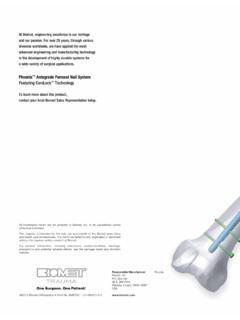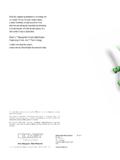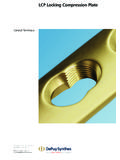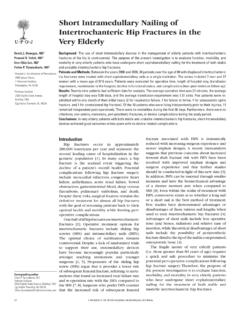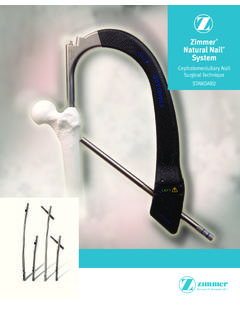Transcription of External Fixation and Temporary Stabilization of Femoral ...
1 External Fixation and TemporaryStabilization of Femoral and TibialTraumaEben A. Carroll, MD,and L. Andrew Koman, MDExternal Fixation is an important option in the acute management of unstable Femoral and tibial fracturesand the Temporary Stabilization of periarticular injuries of the knee or ankle. The value of externalfixation as the modality of choice in selective civilian and military applications is well indications include damage control for multitrauma management in patients with concomitanttraumatized integument and/or excessive swelling and/or systemic instability and Stabilization fortransport in hostile or austere environments. The purpose of this article is to discuss the indications fortemporary External Fixation of lower extremity long bones and complicated distal Femoral , proximal tibia,and tibial plafond fractures; to outline technical considerations in the application of Temporary externalfixation devices; and to summarize the experience in the use of prepackaged External fixators and theirindications in combat.
2 ( Journal of Surgical Orthopaedic Advances 20(1):74 81, 2011)Key words: External fixationExternal Fixation as a temporizing modality in the rapidstabilization of lower extremity long bone and periartic-ular injuries is well documented in both civilian and mili-tary situations. Simple-to-apply fixators may be utilizedin hostile and austere environments without radiographiccontrol in order to provide Temporary Stabilization , tofacilitate transport, and to diminish further soft tissueinjuries. Recent experiences with prepackaged externalfixators in combat situations show them to be effectivein preventing further damage during transport prior todefinitive management. In more controlled environments,uniplanar Fixation affords stable temporization in hemo-dynamically or systemically compromised multitraumapatients or when definitive treatment is not and semirigid External Fixation prevents furthersoft tissue damage, allows recovery of traumatized skinand subcutaneous tissue, permits wound management,allows elective reconstruction of complex fractures andperiarticular injuries and does not negatively impactsystemic complications in multiply injured patients.
3 Thisarticle discusses the historical aspects of External fixa-tion and delineates indications, contraindications, potentialFrom Department of Orthopaedic Surgery, Wake Forest UniversityBaptist Medical Center, Winston-Salem, NC. Address correspondenceto: Eben A. Carroll, MD, Department of Orthopaedic Surgery, WakeForest University Baptist Medical Center, Medical Center Boulevard,Winston-Salem, NC 27157; e-mail: for publication December 25, 2010; accepted for publica-tion December 26, information on prices and availability of reprints call 410-494-4994 $ , technical considerations, and case exam-ples to help the surgeon best determine the role of thismodality in lower extremity fractures.
4 In addition, itreviews the role of self-contained and prepacked sterilefield packs suitable for use on a battlefield or under FixationConceptually, External Fixation utilizes an externalsplinting device, most commonly a bar or frame that isattached to the bone. The interosseous anchoring systemis most commonly a pin or wire. Pins may be half-pinsor full pins, smooth or threaded; they may be self-tappingor require predrilling or tapping. Wires may be thin orthick and tensioned or not tensioned. Most commonlythreaded self-tapping half-pins are utilized. The compo-nents that facilitate attachment of the pin to the barinclude pin-bar/frame articulations and External supportsor crosspieces.
5 Threaded pins are inserted into the bonewith a minimum of two points of Fixation above andbelow the fracture . The strength of the construct maybe increased by double stacking the connecting barsor adding an additional set of pins and bar(s) in adifferent plane, creating a biplanar device. Thin wire fixa-tion employs tensioned wires connected by two or morerings and linked by rods or articulated members and is, ingeneral, a multiplanar construct. Hybrid fixators combinetensioned smooth wire and threaded pin Fixation tech-niques into a single construct. In the Temporary fixationof lower extremity complex injuries, uniplanar devices74 JOURNAL OF SURGICAL ORTHOPAEDIC ADVANCESare preferred; however, there are injuries that cannot bestabilized optimally with uniplanar devices.
6 These simpleconstructs may be uniplanar or biplanar and are coded as application of uniplanar device even if the pins are fixators may be applied in one, two, three, ormore planes. The nomenclature is confusing since CPTcoding differentiates only between one or more , the complexity of the apparatus; the numberand combination of pins, wires, and tensional wires; andthe time required are the most clinically relevant. CPT20690 is application of a uniplane (pins or wires in oneplane), unilateral External Fixation system. Applicationof a multiplane (pins or wires in more than one plane),unilateral, External Fixation system ( , Ilizarov, Monti-celli type) is coded as 20692. This is confusing sincesimple four-pin devices ( , Hoffmann II, Stryker) maybe applied in a uniplanar or biplanar manner with similartime and ease of application (1).
7 The former is unilateral;the latter is multiplanar. Both are simple constructs andthe multiplanar code, while correct, is at best discussion in this article, we have divided fixatorsinto simple or complex and consider damage-control fixa-tions, in general, to be simple with a minimum number ofpins applied in one or two planes and able to be appliedeasily with no or minimal x-ray PerspectiveThe original description of the management of longbone fractures with External Fixation is attributed toKeetley in 1893 (2). In an effort to decrease malunionand nonunion, rigid pins were inserted percutaneouslyinto the femur and attached to an External splint concept was refined by Lambotte (1912), who addedthreaded pins and clamps to facilitate the pin bar inter-face (3).
8 Raoul Hoffmann, Roger Anderson, and othersrefined these techniques and developed closed reduc-tion techniques, minimally invasive protocols, and stableconstructs. Current externalfixation systems still utilizethese primary the early and mid-20th century, good outcomesrelative to other forms of treatment were reported withexternal Fixation devices used in long bone fractures (4, 5).However, nonunion, malunion, and pin tract infectionscomplicated External Fixation treatment. Open tibial frac-tures, treated preferentiallywith External Fixation in the1970s and 1980s, had an inappropriate rate of malunionand pin tract infection (6, 7). More recently, open tibialshaft fractures treated with definitive External fixationhave shown lower patient-oriented outcome measures (8).
9 Pins are the critical element in the External fixationsystem. They transmit forces from the injured bone tothe External support device or bar and have the poten-tial to loosen and over time may become infected (9).Breakdown of this interface can result in loss of fixa-tion, increased motion, and a predisposition to these complications are severe enough to necessi-tate early termination of External Fixation and contributeto poor results seen in this form of management (9).In the 1960s, acute Stabilization of long bone injuries inthe multitrauma patient was associated with an unaccept-ably high mortality rate (10). Acute respiratory compro-mise and pulmonary failure were attributed to fat embolifrom intramedullary instrumentation and suboptimal me-chanical ventilation protocols.
10 Mortality rates approached50% (11). The direct response to these events led to longbone injuries in multiply injured patients being treatedwith splints, casts, or traction (for 2 weeks or more) priorto definitive internal/ External Fixation . The paradigm oftraction or casting without rigid Fixation before definitivestabilization began to change in the 1980s when Bone etal. published a prospective randomized trial comparingearly Fixation of Femoral shaft fractures with traction anddelayed Fixation (12). The findings of this study showedthat the early rigid Fixation group had lower rates of acuterespiratory distress and provided compelling evidence thatearly intervention involving rigid Fixation was prefer-able in multiply injured patients.



